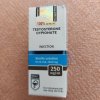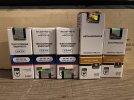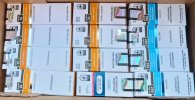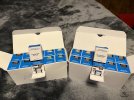Not sure, I need to check with HQ. You can also drop an email on info@hilmabiocare.com with same question, maybe you will receive answer right awayhilmabiocare.co.uk
Is this legit
Navigation
Install the app
How to install the app on iOS
Follow along with the video below to see how to install our site as a web app on your home screen.
Note: This feature may not be available in some browsers.
More options
Style variation
You are using an out of date browser. It may not display this or other websites correctly.
You should upgrade or use an alternative browser.
You should upgrade or use an alternative browser.
MESO-Rx Sponsor RoidTeam - European Distributor
- Thread starter RoidTeam - EU Distributor
- Start date
helo
New Member
Nah. I switched labs and another companys Test E isnt making me get any issues.Try test cip. I like many had switched and it works great little to no pip not like test e anyways. It’s more common than you think.
BlindPanda
New Member
spameggsushi
Member
Placed a drop shipping order with Max Rossman (can you please check for me regarding status of order?) @HilmaBiocare
Dont worry, you are in good handsPlaced a drop shipping order with Max Rossman (can you please check for me regarding status of order?) @HilmaBiocare
kosp
Member
Hilma is very good shit man.
This cycle I am having impressive strength while dropping waist like a mf with aggressive caloric deficit, damn.
This cycle I am having impressive strength while dropping waist like a mf with aggressive caloric deficit, damn.
Thanks for you opinion friend, trying to deliver the best to all of youHilma is very good shit man.
This cycle I am having impressive strength while dropping waist like a mf with aggressive caloric deficit, damn.
Rosapercs
New Member
Anyone know what the issues are with shipping and the bbpower last 2 orders are taking north of 1 month to get scanned in anywhere my last order which is over 1 month old from when it said it shipped is showing no scan information still and i like the website alot but whats this new shipping issue
@HilmaBiocareWhat is up with thebbpower? No prices, cannot login.
Hello. currently i cant say , maybe they have maintenance. Right now we are negotiating with theBBpower on our future work, so if you placed touchdown pictures and want to get discounted on your next order - you should write directly to me and i will forward you to our retail specialistWhat is up with thebbpower? No prices, cannot login.
Drostanolone propionate is an injectable anabolic steroid derived from dihydrotestosterone (DHT). In this case, the base of DHT has been modified with a 2-methyl group to enhance its anabolic properties, making this drug significantly more effective in stimulating muscle growth than its unmethylated counterpart. Drostanolone propionate is described in the literature as "a steroid with powerful anabolic and anti-estrogenic properties (but the latter is not true)," and indeed it does appear to have some of these properties. Nevertheless, its anabolic properties are more correctly described as moderate, especially in the context of other drugs. The drug is most commonly used by dieting bodybuilders and speed sports athletes, where it is in high demand because of its ability to cause a significant increase in lean muscle mass and strength, which is usually accompanied by a decrease in body fat and minimal side effects.
History
Drostanolone propionate was first described in 1959. Syntex developed this drug along with other known steroids such as anadrolone and methyldrostanolone (superdrolone), also first described in the same paper. Drostanolone propionate would be introduced as a prescription drug some ten years later. Lilly had an agreement with Syntex to share certain research and development costs in exchange for the rights to market the results of that research. Thus, Lilly would market Drostanolone Propionate in the United States under the brand name Drolban, and Syntex would market/license it in other markets. Products included Masterone in Belgium (SarvaSyntex) and Portugal (Cilag), Masteril in the UK and Bulgaria, and Methormone in Spain. Drostanolone propionate was also found in such popular products as Permastril (Cassenne, France), Mastisol (Shionogi, Japan), and Masterid (Grunenthal, German Democratic Republic).
Drostanolone propionate for the treatment of advanced inoperable breast cancer in postmenopausal women. This remains the primary clinical indication for the drug in all international markets as well. The prescribing literature reminds physicians and patients that there is significantly less virilization when using drostanolone propionate compared to equal doses of testosterone propionate, suggesting that it is a much more convenient alternative: testosterone injections for this audience. Nevertheless, the indicated dosage level (300 mg per week) was relatively high, and the literature also reminds us that mild symptoms of virilization are still common, such as deepening of the voice, acne, facial hair growth, and enlarged clitoris. It is also reported that severe virilization sometimes follows long-term therapy.
Despite its high popularity among athletes in the 1970s and 80s, drostanolone propionate eventually enjoyed limited success as a prescription drug. Manufacturers soon began to voluntarily discontinue selling the drug in various markets, likely due to the emergence of more effective treatments for breast cancer, as well as a slow decline in steroid prescriptions for this phase of treatment. One of the first drugs was the American Drolban, which was phased out in the late 1980s. Permastril and Methormone were also soon discontinued. The last remaining Western drug containing Drostanolone Propionate was the Belgian Masteron, which disappeared by the late 1990s. Drostanolone propionate is still included in the U.S. pharmacopoeia, suggesting that there is currently no legal impediment to its sale, although its appearance as a prescription drug seems unlikely.
How it's delivered:
Drostanolone propionate is no longer available as a prescription drug. When it was manufactured, it came in 1 and 2 ml ampoules and 10 ml vials containing 50 mg/ml or 100 mg/ml of the steroid in the oil.
Structural Characteristics:
Drostanolone (also known as dromostanolone) is a modified form of dihydrotestosterone. It is distinguished by the introduction of a methyl group at carbon-2 (alpha), which greatly increases the anabolic potency of the steroid by increasing its resistance to metabolism by the 3-hydroxysteroid dehydrogenase enzyme in skeletal muscle tissue. Drostanolone propionate is a modified form of drostanolone in which the carboxylic acid ester (propionic acid) is attached to the 17-beta-hydroxyl group. Esterified steroids are less polar than free steroids and are more slowly absorbed from the injection site. Once in the bloodstream, the ester is split off to form free (active) drostanolone. Esterified steroids are designed to prolong the therapeutic effect after injection, allowing for less frequent injections compared to free (unsterified) steroid injections. The half-life of drostanolone propionate is approximately two days after injection.
Side effects {estrogenic):
Drostanolone is not aromatized by the body and has no noticeable estrogenic effect. There is no need to take anti-estrogens when using this steroid, as gynecomastia should not be a concern even for sensitive people. Since estrogen is the usual culprit for water retention, Drostanolone instead creates good body meat and a quality physique without the fear of excessive subcutaneous fluid retention. This makes it a favorable steroid to use during contraction cycles, when water and fat retention are a major problem. Being a non-aromatizable derivative of DHT.
Side effects {androgenic):
Although the drug is classified as an anabolic steroid, androgenic side effects are still possible, especially when using higher than normal therapeutic doses. These may include oily skin, acne, and body/facial hair growth. Anabolic/androgenic steroids can also exacerbate male-type hair loss. Women are warned about the potential virilizing effects of anabolic/androgenic steroids. These can include deepening of the voice, menstrual irregularities, changes in skin texture, and facial hair growth.
and clitoral enlargement. Drostanolone is a steroid with relatively low androgenic activity compared to its tissue-building effects, making the threshold for severe androgenic side effects comparatively higher than that of more androgenic agents such as testosterone, methandrostenolone, or fluoxymesterone. Note that drostanolone is not affected by the 5-alpha reductase enzyme, so its relative androgenicity is not affected by concomitant use of finasteride or dutasteride.
Side effects {hepatotoxicity):
Drostanolone is not 17-alpha alkylated and has no hepatotoxic properties. Hepatic toxicity is unlikely.
Side effects {Cardiovascular):
Anabolic/androgenic steroids can have detrimental effects on serum cholesterol levels. This includes a tendency to lower (good) cholesterol levels and raise (bad) cholesterol levels, which can change the balance of HDL and LDL toward an increased risk of atherosclerosis. The relative effect of an anabolic/androgenic steroid on serum lipids depends on the dose, route of administration (oral or injectable), type of steroid (aromatizable or non-aromatizable), and degree of resistance to hepatic metabolism. Drostanolone should have a greater negative effect on hepatic cholesterol control than testosterone or nandrolone because of its non-aromatizable nature, but a weaker effect than alkylated c-17 alpha steroids. Anabolic/androgenic steroids can also negatively affect blood pressure and triglyceride levels, decrease endothelial relaxation, and maintain left ventricular hypertrophy, potentially increasing the risk of cardiovascular disease and myocardial infarction. To reduce cardiovascular strain, it is recommended to maintain an active cardiovascular exercise program and minimize saturated fat, cholesterol intake while actively taking AAS.
Side effects {testosterone suppression):
All anabolic/androgenic steroids taken in doses sufficient to gain muscle mass suppress endogenous testosterone production. Therefore, it is mandatory to take a pre-conversion cycle. Please note that steroid abuse can lead to prolonged hypogonadotrophic hypogonadism requiring medical intervention.
History
Drostanolone propionate was first described in 1959. Syntex developed this drug along with other known steroids such as anadrolone and methyldrostanolone (superdrolone), also first described in the same paper. Drostanolone propionate would be introduced as a prescription drug some ten years later. Lilly had an agreement with Syntex to share certain research and development costs in exchange for the rights to market the results of that research. Thus, Lilly would market Drostanolone Propionate in the United States under the brand name Drolban, and Syntex would market/license it in other markets. Products included Masterone in Belgium (SarvaSyntex) and Portugal (Cilag), Masteril in the UK and Bulgaria, and Methormone in Spain. Drostanolone propionate was also found in such popular products as Permastril (Cassenne, France), Mastisol (Shionogi, Japan), and Masterid (Grunenthal, German Democratic Republic).
Drostanolone propionate for the treatment of advanced inoperable breast cancer in postmenopausal women. This remains the primary clinical indication for the drug in all international markets as well. The prescribing literature reminds physicians and patients that there is significantly less virilization when using drostanolone propionate compared to equal doses of testosterone propionate, suggesting that it is a much more convenient alternative: testosterone injections for this audience. Nevertheless, the indicated dosage level (300 mg per week) was relatively high, and the literature also reminds us that mild symptoms of virilization are still common, such as deepening of the voice, acne, facial hair growth, and enlarged clitoris. It is also reported that severe virilization sometimes follows long-term therapy.
Despite its high popularity among athletes in the 1970s and 80s, drostanolone propionate eventually enjoyed limited success as a prescription drug. Manufacturers soon began to voluntarily discontinue selling the drug in various markets, likely due to the emergence of more effective treatments for breast cancer, as well as a slow decline in steroid prescriptions for this phase of treatment. One of the first drugs was the American Drolban, which was phased out in the late 1980s. Permastril and Methormone were also soon discontinued. The last remaining Western drug containing Drostanolone Propionate was the Belgian Masteron, which disappeared by the late 1990s. Drostanolone propionate is still included in the U.S. pharmacopoeia, suggesting that there is currently no legal impediment to its sale, although its appearance as a prescription drug seems unlikely.
How it's delivered:
Drostanolone propionate is no longer available as a prescription drug. When it was manufactured, it came in 1 and 2 ml ampoules and 10 ml vials containing 50 mg/ml or 100 mg/ml of the steroid in the oil.
Structural Characteristics:
Drostanolone (also known as dromostanolone) is a modified form of dihydrotestosterone. It is distinguished by the introduction of a methyl group at carbon-2 (alpha), which greatly increases the anabolic potency of the steroid by increasing its resistance to metabolism by the 3-hydroxysteroid dehydrogenase enzyme in skeletal muscle tissue. Drostanolone propionate is a modified form of drostanolone in which the carboxylic acid ester (propionic acid) is attached to the 17-beta-hydroxyl group. Esterified steroids are less polar than free steroids and are more slowly absorbed from the injection site. Once in the bloodstream, the ester is split off to form free (active) drostanolone. Esterified steroids are designed to prolong the therapeutic effect after injection, allowing for less frequent injections compared to free (unsterified) steroid injections. The half-life of drostanolone propionate is approximately two days after injection.
Side effects {estrogenic):
Drostanolone is not aromatized by the body and has no noticeable estrogenic effect. There is no need to take anti-estrogens when using this steroid, as gynecomastia should not be a concern even for sensitive people. Since estrogen is the usual culprit for water retention, Drostanolone instead creates good body meat and a quality physique without the fear of excessive subcutaneous fluid retention. This makes it a favorable steroid to use during contraction cycles, when water and fat retention are a major problem. Being a non-aromatizable derivative of DHT.
Side effects {androgenic):
Although the drug is classified as an anabolic steroid, androgenic side effects are still possible, especially when using higher than normal therapeutic doses. These may include oily skin, acne, and body/facial hair growth. Anabolic/androgenic steroids can also exacerbate male-type hair loss. Women are warned about the potential virilizing effects of anabolic/androgenic steroids. These can include deepening of the voice, menstrual irregularities, changes in skin texture, and facial hair growth.
and clitoral enlargement. Drostanolone is a steroid with relatively low androgenic activity compared to its tissue-building effects, making the threshold for severe androgenic side effects comparatively higher than that of more androgenic agents such as testosterone, methandrostenolone, or fluoxymesterone. Note that drostanolone is not affected by the 5-alpha reductase enzyme, so its relative androgenicity is not affected by concomitant use of finasteride or dutasteride.
Side effects {hepatotoxicity):
Drostanolone is not 17-alpha alkylated and has no hepatotoxic properties. Hepatic toxicity is unlikely.
Side effects {Cardiovascular):
Anabolic/androgenic steroids can have detrimental effects on serum cholesterol levels. This includes a tendency to lower (good) cholesterol levels and raise (bad) cholesterol levels, which can change the balance of HDL and LDL toward an increased risk of atherosclerosis. The relative effect of an anabolic/androgenic steroid on serum lipids depends on the dose, route of administration (oral or injectable), type of steroid (aromatizable or non-aromatizable), and degree of resistance to hepatic metabolism. Drostanolone should have a greater negative effect on hepatic cholesterol control than testosterone or nandrolone because of its non-aromatizable nature, but a weaker effect than alkylated c-17 alpha steroids. Anabolic/androgenic steroids can also negatively affect blood pressure and triglyceride levels, decrease endothelial relaxation, and maintain left ventricular hypertrophy, potentially increasing the risk of cardiovascular disease and myocardial infarction. To reduce cardiovascular strain, it is recommended to maintain an active cardiovascular exercise program and minimize saturated fat, cholesterol intake while actively taking AAS.
Side effects {testosterone suppression):
All anabolic/androgenic steroids taken in doses sufficient to gain muscle mass suppress endogenous testosterone production. Therefore, it is mandatory to take a pre-conversion cycle. Please note that steroid abuse can lead to prolonged hypogonadotrophic hypogonadism requiring medical intervention.
Deivids
New Member
Hi @HilmaBiocare
I have a question.
Is the oil used in Testosterone Undecaonate the same as in Cypionate?
What oil is used in each case?
Thanks!
I have a question.
Is the oil used in Testosterone Undecaonate the same as in Cypionate?
What oil is used in each case?
Thanks!
Hey, yes its the same and its Sesame OilHi @HilmaBiocare
I have a question.
Is the oil used in Testosterone Undecaonate the same as in Cypionate?
What oil is used in each case?
Thanks!
Deivids
New Member
Thanks!Hey, yes its the same and its Sesame Oil
You are welcome. Feel free to contact us with any questionsThanks!
Mongo88
New Member
Touchdown baby ! I’ve been ordering from theBBpower for over a year now, many orders, and I love there shit. Great customer service support, and has always gotten to me here in the USA. Once and a while the usps will not scan things in and or take a bit longer than normal in shipping, but always gotten my order. Usually within 3 weeks or sooner. Great gains! Just wanna be a monster and look good naked ! And a sex drive that will send the wife running lol. I love hilmabio gear. And definitely like there new transparent vials and great looking boxes/packaging, labels and security genuine stickers. Gives it all a better professional look. They definitely take pride in there product as they should, it’s been great for me.
Attachments
Thank you for your feedback friend! We are very please you are happy with the products and service!Touchdown baby ! I’ve been ordering from theBBpower for over a year now, many orders, and I love there shit. Great customer service support, and has always gotten to me here in the USA. Once and a while the usps will not scan things in and or take a bit longer than normal in shipping, but always gotten my order. Usually within 3 weeks or sooner. Great gains! Just wanna be a monster and look good naked ! And a sex drive that will send the wife running lol. I love hilmabio gear. And definitely like there new transparent vials and great looking boxes/packaging, labels and security genuine stickers. Gives it all a better professional look. They definitely take pride in there product as they should, it’s been great for me.
Similar threads
- Replies
- 83
- Views
- 2K
- Replies
- 833
- Views
- 64K
- Replies
- 89
- Views
- 7K
- Replies
- 94
- Views
- 6K
- Replies
- 48
- Views
- 2K





